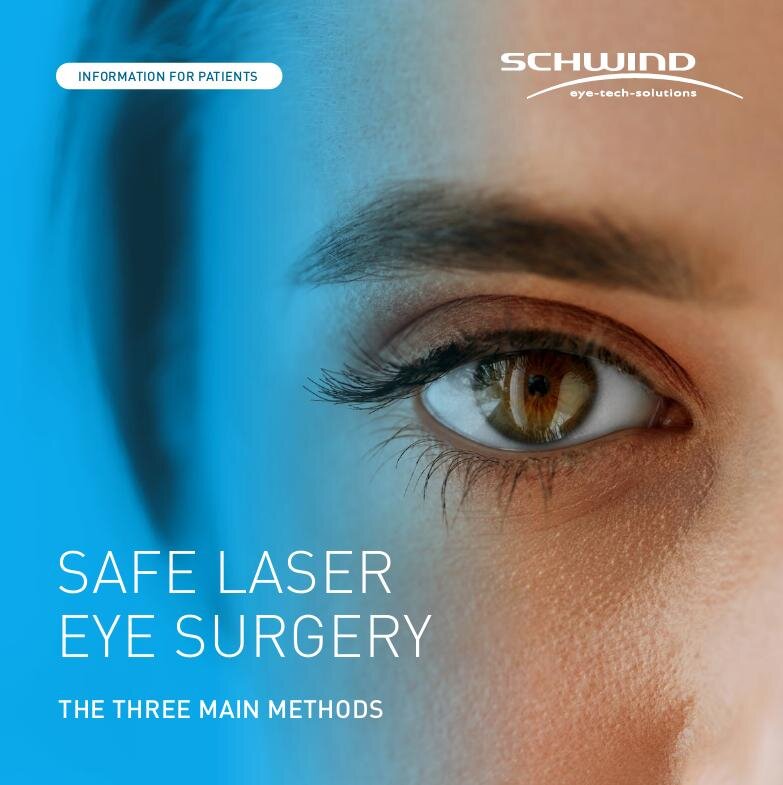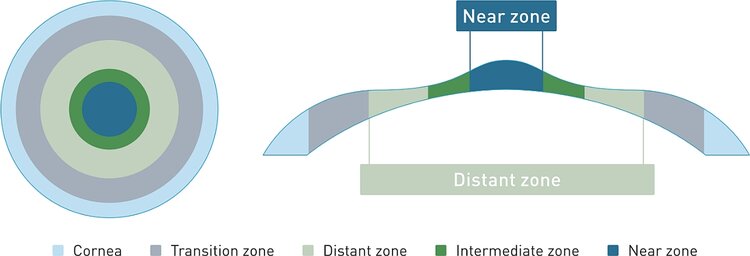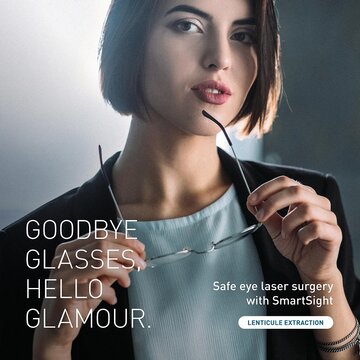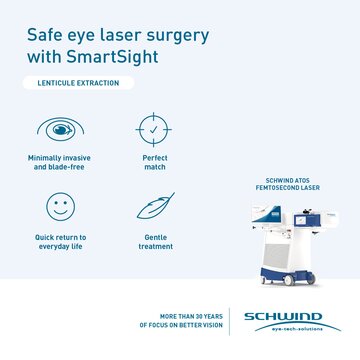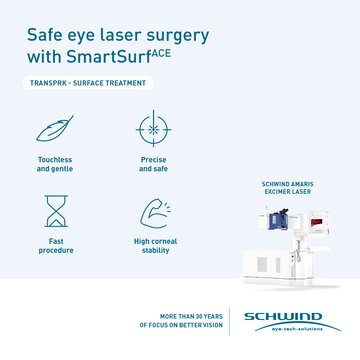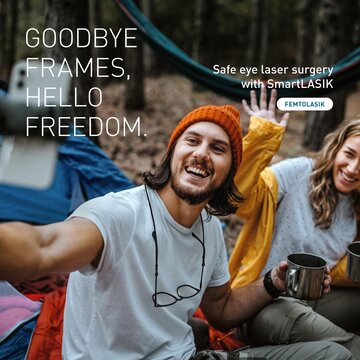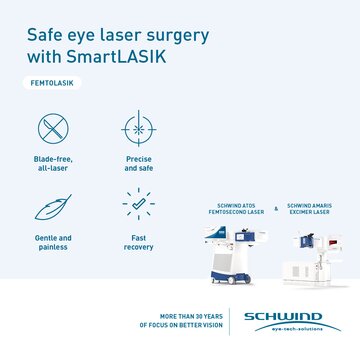Types of eye surgery – Which one is right for you?
Eye laser corrections have been performed since 1987. The technology and techniques have improved steadily, and today there is a wide range of different methods.
What they all have in common is that the shape of the cornea is modified by a laser. The laser treatment takes only a few seconds and is done with locally anaesthetising eye drops. There is no pain during the treatment. The treatment methods are primarily distinghuished by how they deal with the epithelium, which is a protective tissue covering the outside of the cornea. This results in differences in the kinds of vision corrections that are possible, recovery times, and other considerations.
Every eye is unique.
Only an eye surgeon can advise you on the treatment options that are best for you.
Treatment methods in comparison
As one of the technology leaders, SCHWIND offers very sophisticated techniques that enable optimum vision correction. This includes aberration-free treatment that corrects vision defects without changing the patient’s accustomed visual impression. Treatment using wavefront data addresses higher-order defects and improves vision quality to the greatest possible extent.
Compare the different types of laser eye surgery:
Lenticule Extraction
SmartSight
SmartSight uses no corneal flap and there is no laser ablation like there is with excimer lasers. In the SmartSight procedure, the SCHWIND ATOS femtosecond laser prepares a thin slice (lenticule) in the intrastromal tissue of the cornea and a creates a small opening. The lenticule is removed through the small opening.

Surface treatment
TransPRK / SmartSurfACE (no touch)
TransPRK by SCHWIND is the only surface treatment in which the eye is not touched by any instrument. No suction is applied to the eye, and the cornea is not cut. The outermost, regenerating corneal layer (epithelium) does not need to be manually removed, and no alcohol solution is used. Instead, to improve the patient’s vision, the excimer laser models the cornea through the epithelium. The top corneal layer grows back quickly. Since 2009, TransPRK – with SCHWIND AMARIS laser systems – has grown more and more popular. The SmartSurfACE technique combines TransPRK with SCHWIND SmartPulse, a unique technology that greatly speeds healing and provides good vision quality immediately after the treatment.

SmartSurfACE eye surgery

SmartSurfACE
PRK (photorefractive keratectomy)
PRK is the eye lasering method that has been in use the longest, since 1987. Today it is used primarily in cases where the cornea is very thin. In PRK treatment, the outermost, regenerating corneal layer (epithelium) is mechanically removed with a blade or rotating brush. The corneal surface is then modelled with the laser. The epithelium regenerates itself within a week.
LASEK (laser epithelial keratomileusis)
LASEK treatment is a refinement of PRK and has been in use since 1999. It combines the advantages of LASIK and PRK in a single procedure. In LASEK, no corneal flap is cut. Instead the outer corneal layer (epithelium) is detached with alcohol and moved to the side. The corneal tissue under it is then modelled with the laser. Afterwards, the epithelium is pushed back into place, where it adheres automatically.
Flap techniques

LASIK (laser in-situ keratomileusis)
In LASIK, a blade cuts a thin flap in the cornea, which is folded to the side before the laser treatment. The corneal tissue under it is then modelled with the excimer laser. Afterwards the flap is folded back into place, where it adheres automatically. This procedure was first tested in 1990.
Femto-LASIK (laser in-situ keratomileusis)
Femto-LASIK uses two different types of laser. First, a femtosecond laser is used to cut a corneal flap, which is folded to the side. An excimer laser then models the corneal tissue underneath. After excimer lasering the flap is folded back into place, where it adheres automatically. The first Femto-LASIK procedures were performed in 2000.
Special treatment options
Wavefront-guided laser treatment
For pronounced higher-order defects, also known as aberrations, the doctor can recommend treatment using wavefront technology.
A perfect eye reflects light rays in such a way as to form a smooth wavefront. But no eye is quite perfect, so the reflected light shows a wavefront with an individual pattern. Wavefront analysis detects whether there are pronounced higher-order vision defects. These are measured with the SCHWIND Diagnostic Devices. Corneal wavefront data can reveal even the smallest uneven places on the cornea, comparable to a detailed elevation map. Combining this with ocular wavefront data, meaning the light reflected by the cornea and lens, makes the diagnosis even more accurate. Higher-order defects on the corneal surface are analysed in context with individual deviations in the entire eye. This permits laser treatment that is tailored exactly to that specific eye.
Aberration-free treatment – retaining the accustomed visual impression
In this technique, developed by SCHWIND, common visual defects like nearsightedness, farsightedness and astigmatism are treated without changing the small higher-order defects that many people have and which do not interfere with good vision. This means that the patient retains the accustomed visual impression, so the brain doesn’t have to go through a learning phase.
The decision for treatment should only be made under professional medical supervision and recommendation. Please consult your ophthalmologist/eye specialist for an examination and advise on suitable treatment.
From around 45 years of age, the near vision of almost all people distinctly declines. This is not caused by any sort of visual defect, but rather a perfectly natural, age-related process whereby the lens of the eye loses mobility. For that reason, the eye becomes unable to adjust clearly to different distances. Blurred vision, especially at close range, is the result.
For the treatment of presbyopia – the medical term for age-related long-sightedness – alternatives to reading or varifocal glasses along with multifocal contact or intraocular lenses are now available.
PresbyMAX® Your clear choice for greater freedom and quality of life
PresbyMAX is a method of presbyopia treatment performed using technologically advanced SCHWIND AMARIS eye laser systems. The treatment is completed in just a few minutes, and the actual laser ablation takes only seconds. The procedure neither touches nor replaces the sensitive lens of the eye. Rather, rapid laser pulses gently model the cornea with high precision.
Several different treatment variants are possible with the PresbyMAX procedure. Your specialist will advise you about the variant which suits you best.
Unlike conventional LASIK treatment, multiple precisely calculated focal points are created in the eye – similar to the principle applied in multifocal contact or intraocular lenses. The cornea is modelled at the centre for near vision and towards the periphery for distant vision. This results in a good depth of field and very high quality vision at all distances. Visual acuity typically improves very rapidly following treatment at a rate roughly comparable to the case of conventional LASIK treatment.
